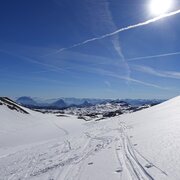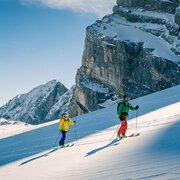The Classic Ski Tour "Über den Stein" - Guttenberghaus
Tour description
The descent is spectacularly scenic and although only a few metres in altitude are covered on the ascent, this tour requires skiing ability and stamina. Experience in assessing the avalanche situation is required. The route is only partially marked.
The tour
Map, elevation profile & further information
The route leads almost exclusively through open ski terrain. Alpine knowledge is important in this terrain, orientation becomes extremely difficult in fog. Avalanche assessment is required for the descent. Always pay attention to the avalanche report and weather forecast.
We always recommend that you are accompanied by a local mountain and ski guide!
Exit from the B320 Ennstal Bundesstraße in Schladming-Mitte. Continue on the Ramsauer Landesstraße to Ramsau am Dachstein. Through the village to the Dachstein toll road and via this to the valley station of the Dachstein glacier railway.
Car park at the Dachstein Gletscherbahn valley station.From Schladming railway station, take bus no. 960 to the Dachstein Gletscherbahn valley station.
Timetable at www.rvb.at
- Clothing and protective equipment: Make sure you are prepared for rapid changes in the weather and the increased UV exposure in high alpine terrain. A wind and water-repellent jacket, hood and moisture-resistant gloves are essential. Sun protection (eyes, skin and lips) is also very important.
- Safety equipment: A modern avalanche transceiver, a metal avalanche shovel and a probe are part of the basic equipment for every ski tour and freeride descent that takes you away from the secured slopes and into the open ski area. This triumvirate of avalanche transceiver/shovel/probe is not only used to be found quickly in the event of an avalanche, but above all to be able to quickly help any companions or other buried people.
- You'll have your smartphone with you anyway. It's generally advisable to install a GPS app and familiarize yourself with how to use it. Network coverage is generally good on the Dachstein.
- If you don't have any network reception, please restart your phone. Before you enter your PIN code for the SIM card, dial the emergency number. You can also make the emergency call in other networks.
- A small first aid kit with a multi-tool should also always be with you.
Equipment for these variant:
- Standard safety equipment (avalanche transceiver, shovel, probe, first aid)
- Phone, GPS app. Network coverage is sufficient.
The Dachstein Mountains - which consist mainly of the well-known Dachstein limestone - are karstified and riddled with caves and sinkholes. This poses dangers, especially in times of little snow. There are many crevasses of different sizes on the glaciers, often only lightly covered in snow and therefore difficult to see. Please therefore stay on the marked paths, especially on the beginner tours.
The tours described start above the tree line. The dominant glaciers (the Schladming and the larger Hallstatt glacier to the west) face northeast and north, respectively, and are susceptible to rapid changes in the weather. Another big issue is fog that comes in quickly or lasts for a long time, which can cause a significant drop in temperature. Please inform yourself about the weather and snow conditions before your tour and bring sufficient protective equipment with you.
Avalanche report
Read the current avalanche report before your tour and familiarize yourself with the avalanche warning levels. You can find all the information here: www.lawine-steiermark.at.
You can find contacts to our mountain guides at www.schladming-dachstein.at/bergfuehrer.
The terrain is often highly structured and - with the exception of the areas below approx. 1,800 m above sea level - also treeless. This often makes orientation difficult. In fog (“white out”), orientation can become almost impossible. For more challenging tours, we strongly recommend that you use a GPS device and carry the appropriate safety equipment.
As a general rule, when you leave the marked and open pistes, you are in open ski terrain. The open ski terrain is not marked and not secured against alpine dangers.
Most of the tours described are between 1,800 and 3,000 meters above sea level. At these altitudes, your body sometimes reacts more strongly to stress. Your breathing becomes faster and your need for fluids increases. Please take this important fact into account when planning your tour.
Catering
There are several huts and restaurants in the Dachstein massif that are also open in winter. For example, the Dachstein Glacier Restaurant at the mountain station, the Seethalerhütte, the Simonyhütte, the Wiesberghaus, the Gjaidalm and the Krippenstein Lodge. Nevertheless, it is necessary to always take enough liquid and food (e.g. muesli bars) with you. There are no refreshment stops on some of the routes described.
The alpine emergency number in Austria is 140 (Europe 112).







